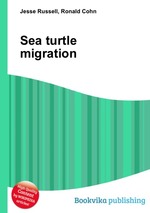Sea turtle migration
Jesse Russell Ronald Cohn
бумажная книга
High Quality Content by WIKIPEDIA articles! Sea turtle migration refers to the long-distance movements of sea turtles (superfamily Chelonioidea) notably as adults but may also refer to the offshore migration of hatchings. Sea turtle hatchings emerge from underground nests and crawl across the beach towards the sea. They then maintain an offshore heading until they reach the open sea. The feeding and nesting sites of adult sea turtles are often distantly separated meaning some must migrate hundreds or even thousands of kilometres. Several main patterns of adult migration have been identified. Some such as the green sea turtle shuttle between nesting sites and coastal foraging areas. The loggerhead sea turtle uses a series of foraging sites. Others such as the leatherback sea turtle and olive ridley sea turtle do not show fidelity to any specific coastal foraging site. Instead, they forage in the open sea in complex movements apparently not towards any goal. Although the foraging movements of leatherbacks seem to be determined to a large part by passive drift with the currents, they are still able to return to specific sites to breed. The ability of adult sea turtles to travel to precise targets has led many to wonder about the navigational mechanisms used. Some have suggested that juvenile and adult turtles might use the Earth`s magnetic field to determine their position. There is evidence for this ability in juvenile green sea turtles.


